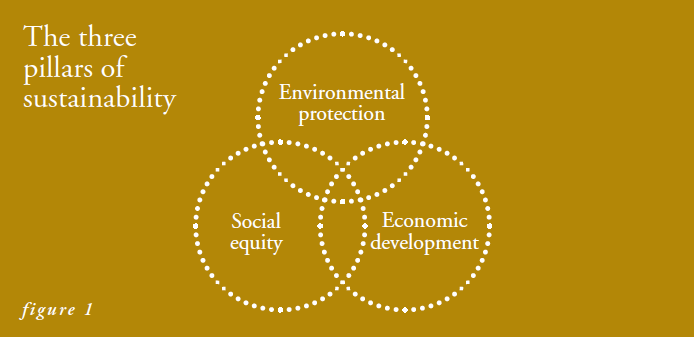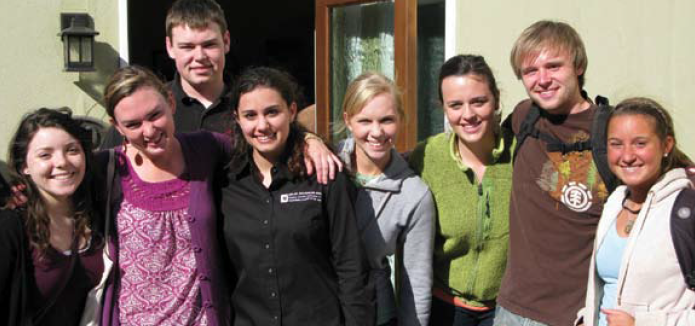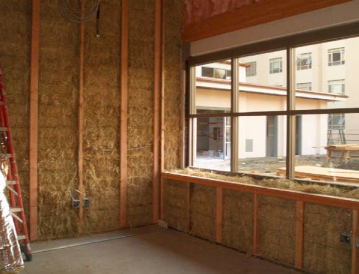Sustainability in Catholic Higher Education
Origins and meanings
The World Commission on Economic Development brought the idea of sustainability to the global stage in 1987. The United Nations sponsored this study of the relationship between economic development and the environment, published as “Our Common Future,” also known as “The Brundtland Report.” Prior to this, the United Nations had struggled to find a way to address global environmental problems.
The industrialized countries had proposed international treaties and action, but the developing nations had prioritized the need for economic development, with little interest in environmental regulation. The commission provided the conceptual framework for coordinated action, proposing that all nations have a stake in fostering economic development, but of a new kind: sustainable. It proposed sustainability as an integral framework, in which economic development, social equity, and environmental protection are seen as inseparably related goals.
The Brundtland Commission advanced public understanding of the link between economic growth of the poorer nations and global environmental protection. The commission argued that poorer countries must have the opportunity to develop economically— if they are denied this opportunity it will be much harder to convince all countries to support practices that can be sustained over time—but richer countries must foster policies to favor environmental conservation with economic development. “Our Common Future” laid the foundation for the “Earth Summit” at Rio de Janeiro, Brazil, in 1992. This summit marked the real beginning of international environmental protection initiatives and proposed a sustainable development agenda. A simple definition of sustainability is “meeting the needs of the present generation without compromising the ability of future generations to meet their needs.” The official U.N. definition of sustainability has three dimensions, or three pillars, also known as the “Three Es” of sustainability. These are environmental protection, economic development, and social equity (figure 1).

Sustainability has now become a concern of virtually every sector of human society. It enjoys more popular support than environmental resource conservation because it focuses on human needs, but also because it provides a positive vision for the future of the human family. From a motivational perspective, few people are inspired by the notion of “being less bad” in their environmental impact. In contrast, sustainability provides a framework and markers for making positive change.
The justice dimension of sustainability
The social equity pillar has the clearest ethical component, that of socio-economic fairness or social justice. The lifestyles of the richest and poorest members of the human family pose the greatest threat to the integrity of Earth’s life support systems, but for different reasons. The wealthiest consume vastly more than their fair share of resources, more than the planet can provide for everyone. The poorest 1/3 of human society, those living on less than $2 per day, have no alternative but to use resources in a short-sighted way—for example, cutting down trees for firewood before they are able to grow to their full height. The wealthiest countries have the capacity to make choices for a more sustainable lifestyle, while the poorest members of the human family generally do not. Thus, sustainability is built upon the practice of solidarity with the poor; fostering economic development for them will enhance sustainability. The social equity dimension suggests that sustainable development is an inherent moral good, but its consequences are likely to be ethically positive as well.
The sustainability framework extends ethical concern to future generations. Human society now consumes natural resources faster than they can be replenished, and this is compromising the ability of future generations to meet their needs. Current and future generations are inheriting a world that is biologically impoverished, has fewer resources, and suffers from more pollution than ever before.Sustainability challenges present day humans to consider the well-being of future generations, to view their needs as worthy of our moral concern. Modern humans are not accustomed to considering future generations, but the power of our markets and technologies threatens their quality of life. We can express a moral concern for the future by restraining our consumption of non-renewable resources today. Note that some resources, such as minerals, are essentially finite. Other resources, such as wind and plants, because they draw their energy from the sun, can be managed so as to provide a continuous source of goods.

It is important to recognize that sustainability, much like “efficiency,” does not have an intrinsic meaning. In a simplistic sense, sustainability merely means the capacity to keep doing something. For example, some economic institutions use the term to communicate their ability to sustain their business activities, but this reflects their self-interest. Some governments use the term only in regard to national economic growth. This is why the social equity dimension of sustainability is so critical. Some use the term “environmental sustainability,” but this makes no sense without its two companion pillars. An ethical approach to sustainability suggests that society has an obligation to restrain wasteful uses of resources among the affluent, but it also has a special obligation to foster economic development for the poorest of the poor, all the while maintaining environmental resource protection. When referring to sustainable development, one needs to define what is to be sustained, for whom, and for how long. Sustainability is not an absolute condition, but always partial. Sustainability, like justice, occurs along a continuum, and making progress along this continuum is necessarily incremental. Restraint is its price.
Sustainability at Santa Clara
Catholic higher education offers opportunities— and has obligations—to advance sustainability. Santa Clara University adopted a comprehensive policy on sustainability in 2004, addressing environmental stewardship, education, and service. All activities are now coordinated by the Office of Sustainability. University Operations coordinates the stewardship of the campus facilities. The Environmental Studies Institute has taken the lead in educational efforts. Environmental Services facilitates outreach from SCU students and faculty to communities near and far. University Operations has long cared for the comfort and beauty of our SCU learning environment, but has added resource efficiency to its responsibilities. All new facilities must meet stringent “green” building standards. This resource stewardship is good in and of itself, but these buildings also serve as learning laboratories for the broader campus community. University Operations carries out an integrated strategy that allows for campus growth while reducing overall use of energy and water resources.

Educational theorists have proposed a fourth pillar of sustainability to integrate the original three: education (figure 2). We need leaders able to foster innovation and collaboration among engineers, business officials, social and natural scientists, and scholars in the humanities. Indeed, sustainability challenges every human organization—private, public and community-based—to become a learning institution. Today at Santa Clara, sustainability is incorporated into teaching across more than twenty disciplines.
Sustainability challenges the traditional segmentation of research and learning into isolated academic disciplines. Sustainability requires critical inquiry all the more, but across and between multiple intellectual domains, as society struggles to balance all three pillars. In deliberating a new undergraduate core curriculum, the campus faculty decided not to require students to take a designated course in sustainability, but rather to weave this theme into disparate—and perhaps surprising— disciplinary courses, such as mathematics, psychology, philosophy, religious studies, marketing, geology, and poetry. This educational strategy challenges students to make connections across the disciplines, and come to grips with sustainability’s complex interdisciplinary character.
Sustainability is shaping research and outreach at Santa Clara as well. Not content to win the bronze medal in the international solar decathlon competition, engineering faculty have begun a research project in quantifiable sustainability. Some arts and sciences students created a “sustainability decathlon” outreach project to local high schools, piggy-backing community outreach on the 2007 solar house, and now again in 2009. The Global Social Benefit Incubator (GSBI), a project of the University’s Center for Science, Technology, and Society, provides an intensive two-week residential program that enables successful social entrepreneurs to scale up their endeavors while incorporating sustainability principles. The GSBI combines the discipline of business planning and Silicon Valley’s entrepreneurial resources with sensitivity to culturally embedded models of social change across the globe.

Advancing toward sustainability goals requires scientific and technical expertise to be linked with moral and political leadership skills. Jesuit education has been an engine of cultural creativity from its origins in 1548. The principles of sustainability readily take root in the humanist foundation of Jesuit education, but this calls for additional attention to humanity’s relationship to our natural and built environments. No longer can one study society without regard to nature, any more than one can study technology without its human impacts. Making progress along the sustainability continuum requires studying humans and nature—together—as they inevitably mutually influence each other. Our Jesuit tradition of integrated education means Santa Clara University is uniquely poised to be able to develop the kind of whole-person leaders necessary to lead us into a more sustainable future. The humanistic values of Jesuit education offer us an advantage as we educate the whole person, in solidarity with the poor and needy, in a globalized world.
